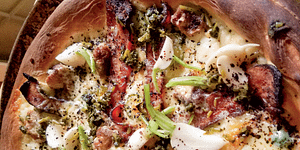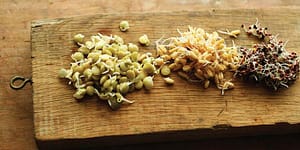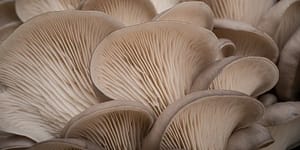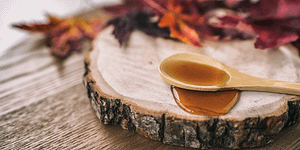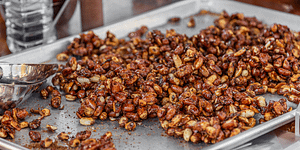Unbelievably Delicious Sauerkraut Chocolate Cake

Finding a recipe that produces a flavorful cake without having to compromise the texture is difficult, but this recipe delivers on both flavor AND texture. The unlikely combination of chocolate and sauerkraut yields an absolutely delicious and moist chocolate cake, perfect for your next craving!
The following is an excerpt from Sandor Katz’s Fermentation Journeys by Sandor Ellix Katz. It has been adapted for the web.
Chocolate Cake With Sauerkraut
Many people seem shocked at the idea of a chocolate cake made with sauerkraut. But it is quite delicious and moist, and the sauerkraut blends into the sweet cake just like the shredded carrot in a carrot cake or the zucchini in a zucchini bread.
The sourness of the kraut is mostly neutralized as it reacts with the alkaline baking soda, and the reaction between them is part of what rises the cake.
Sauerkraut: The Secret Ingredient
Sauerkraut chocolate cake was first served to me at a wonderful fermentation themed feast in Amery, Wisconsin, where the dessert course was prepared by pastry chef Leigh Yakaites.
Leigh told me her grandmother, from Fond du Lac, Wisconsin, used to make sauerkraut chocolate cake when Leigh was young, though “she of course didn’t tell the kids it had sauerkraut in it until we had eaten it.”
Leigh didn’t follow a family recipe, but she directed me to one published online by Canadian food blogger Bernice Hill, on her website Dish ‘n’ the Kitchen (dishnthekitchen.com). Because I am constitutionally unable to follow a recipe, I have adapted hers, and I offer this as a guideline for you to adapt further.
Tips for Serving
Spread jam between the layers; I thought marmalade worked especially well, but any fruity jam would be great. Leigh served it covered with a fantastic chocolate balsamic glaze—her recipe for that is included. A simple chocolate icing or whipped cream would be fine as well.
As for the sauerkraut, I recommend a very simple and plain kraut without a lot of additional ingredients beyond finely shredded cabbage and salt.
RECIPE:Sauerkraut Chocolate Cake
Timeframe
About 2 hours including cooling time
Equipment
- Two 8-inch/20-centimeter round cake pans
- Parchment paper
- Whisk or electric mixer
Ingredients
for two layers of an 8-inch/ 20-centimeter round cake
- 1/4 cup/170 grams butter, room temperature
- 1 1/2 cups/300 grams sugar
- 3 eggs
- 1 teaspoon vanilla extract
- 2 1/4 cups/380 grams white flour
- 1/2 cup/75 grams cocoa powder
- 1 teaspoon baking soda
- 1 teaspoon baking powder
- 1/2 teaspoon salt
- 1 cup/160 grams sauerkraut, drained and squeezed of excess juice, and very finely shredded
- 1/2 cup/65 grams cacao nibs (optional)
- 1/2 cup/120 milliliters jam of your choice to spread between the layers
Ingredients
for the Chocolate Balsamic Glaze
- 2/3 cup/160 milliliters balsamic vinegar
- 3 tablespoons sugar
- 1.5 ounces/45 grams bittersweet baking chocolate, grated or cut into small pieces

Photo Credit: Sarah Hoski
Process
Preheat oven to 350°F/175°C.
Prepare two 8-inch/20-centimeter round cake pans: Rub butter on interior surfaces, dust with flour, and line bottoms with parchment paper.
Cream the butter and sugar together, using a whisk or electric mixer, until smooth.
Add the eggs one at a time, mixing each one in until smooth.
Add the vanilla and mix until smooth.
In another bowl, combine the dry ingredients, then sift them slowly into the butter-sugar-egg mixture, mixing well with a spoon or spatula.
Add 1 cup/250 milliliters of water, a little a time, as you stir it into a smooth batter.
Add the sauerkraut and cacao nibs (if using), and stir to mix them in thoroughly.
Pour the batter into the two prepared pans.
Bake for 30 minutes, then stick a toothpick or fork into the center of one of the cakes to see if it comes out clean. If so, remove the cakes from the oven; if not, bake for another 5 minutes.
Allow the cakes to cool on a rack until they are cool enough to handle. Then remove from the baking pans and peel the parchment paper from the bottoms of the cakes.
For the glaze, combine the balsamic vinegar and sugar in a saucepan, whisking them together and heating until it is hot but not boiling. When the sugar is fully dissolved, remove from heat and whisk in the chocolate until it is melted.
Place one layer of the cake on a serving plate or cake stand, spread jam on top of it, then place the second layer on the jam. Pour the glaze over the top and sides of the cake.
Enjoy!
Recommended Reads
Making the Best Sauerkraut on Earth in Four Simple Steps: Chop, Salt, Pack, Wait
Recent Articles
Nothing says “spring” like a fresh, foraged meal! Savor the flavors of the season with this Milkweed Bud Pizza recipe.
Read MoreWhat’s so great about oyster mushrooms? First, you can add them to the list of foods that can be grown indoors! They are tasty, easy to grow, multiply fast, and they love a variety of substrates, making oyster mushrooms the premium choice. The following is an excerpt from Fresh Food from Small Spaces by R. J.…
Read MoreCraving something sweet? These delicious maple roasted nuts are the perfect treat to help you push through those end-of-winter blues. The following is an excerpt from Full Moon Feast by Jessica Prentice. It has been adapted for the web. The Magic of Maple: A Rich History Following the Hunger Moon, just before the first thaw…
Read More




